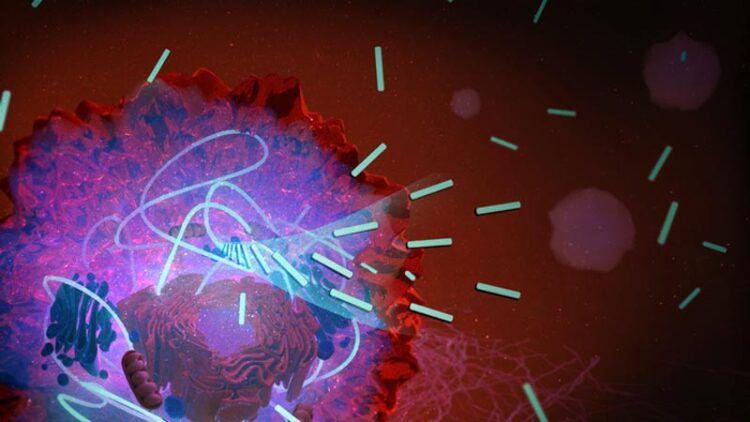Suffocating cancer cells

Artistic illustration of a new method of cancer therapy: due to the conditions in a cancer cell, molecules - drawn here in light green - can join together to form long hairs. These then stop the conversion of oxygen into energy, which the cell needs to grow. The result: the cancer cell dies.
Credit: Max Planck Institute for Polymer Research
Self-assembling molecules could help in cancer therapy.
Treatment of cancer is a long-term process because remnants of living cancer cells often evolve into aggressive forms and become untreatable. Hence, treatment plans often involve multiple drug combinations and/or radiation therapy in order to prevent cancer relapse. To combat the variety of cancer cell types, modern drugs have been developed to target specific biochemical processes that are unique within each cell type.
However, cancer cells are highly adaptive and able to develop mechanisms to avoid the effects of the treatment. “We want to prevent such adaptation by invading the main pillar of cellular life – how cells breathe – that means take up oxygen – and thus produce chemical energy for growth,” says David Ng, group leader at the MPI-P.
The research team produced a synthetic drug that travels into cells where it reacts to conditions found inside and triggers a chemical process. This allows the drug’s molecules to bind together and form tiny hairs that are a thousand times thinner than human hair. “These hairs are fluorescent, so you can look at them directly with a microscope as they form,” says Zhixuan Zhou, an Alexander-von-Humboldt-fellow and first author of the paper.
The scientists monitored the oxygen consumption in different cell types and found that the hairs stop all of them from converting oxygen into ATP, a molecule that is responsible for energy delivery in cells. The process worked even for those cells derived from untreatable metastatic cancer. As a result, the cells die rapidly within four hours. After some more years of research, the scientists hope that they can develop a new method to treat up-to-now untreatable cancer.
Weil, Ng and colleagues have shown an exciting outcome under controlled laboratory culture and will continue to unravel deeper insights on the basis of how these tiny hairs prevent the conversion of oxygen to chemical energy. With further development, these objects could in the future possibly also be manipulated to control other cellular processes to address other important diseases.
They have published their results in the renowned Journal of the American Chemical Society.
Journal: Journal of the American Chemical Society
DOI: 10.1021/jacs.2c03215
Method of Research: Experimental study
Subject of Research: Cells
Article Title: In Situ Assembly of Platinum(II)-Metallopeptide Nanostructures Disrupts Energy Homeostasis and Cellular Metabolism
Article Publication Date: 21-Jun-2022
Media Contact
All latest news from the category: Life Sciences and Chemistry
Articles and reports from the Life Sciences and chemistry area deal with applied and basic research into modern biology, chemistry and human medicine.
Valuable information can be found on a range of life sciences fields including bacteriology, biochemistry, bionics, bioinformatics, biophysics, biotechnology, genetics, geobotany, human biology, marine biology, microbiology, molecular biology, cellular biology, zoology, bioinorganic chemistry, microchemistry and environmental chemistry.
Newest articles

Sea slugs inspire highly stretchable biomedical sensor
USC Viterbi School of Engineering researcher Hangbo Zhao presents findings on highly stretchable and customizable microneedles for application in fields including neuroscience, tissue engineering, and wearable bioelectronics. The revolution in…

Twisting and binding matter waves with photons in a cavity
Precisely measuring the energy states of individual atoms has been a historical challenge for physicists due to atomic recoil. When an atom interacts with a photon, the atom “recoils” in…

Nanotubes, nanoparticles, and antibodies detect tiny amounts of fentanyl
New sensor is six orders of magnitude more sensitive than the next best thing. A research team at Pitt led by Alexander Star, a chemistry professor in the Kenneth P. Dietrich…





















